Superregnum: Eukaryota
Cladus: Unikonta
Cladus: Opisthokonta
Cladus: Holozoa
Regnum: Animalia
Subregnum: Eumetazoa
Cladus: Bilateria
Cladus: Nephrozoa
Superphylum: Deuterostomia
Phylum: Chordata
Subphylum: Vertebrata
Infraphylum: Gnathostomata
Megaclassis: Osteichthyes
Cladus: Sarcopterygii
Cladus: Rhipidistia
Cladus: Tetrapodomorpha
Cladus: Eotetrapodiformes
Cladus: Elpistostegalia
Superclassis: Tetrapoda
Cladus: Reptiliomorpha
Cladus: Amniota
Classis: Reptilia
Cladus: Eureptilia
Cladus: Romeriida
Subclassis: Diapsida
Cladus: Sauria
Infraclassis: Archosauromorpha
Cladus: Crurotarsi
Divisio: Archosauria
Cladus: Avemetatarsalia
Cladus: Ornithodira
Subtaxon: Dinosauromorpha
Cladus: Dinosauriformes
Cladus: Dracohors
Cladus: Dinosauria
Ordo: Saurischia
Cladus: Eusaurischia
Subordo: Theropoda
Cladus: Neotheropoda
Cladus: Averostra
Cladus: Tetanurae
Cladus: Avetheropoda
Cladus: Coelurosauria
Cladus: Tyrannoraptora
Cladus: Maniraptoromorpha
Cladus: Maniraptoriformes
Cladus: Maniraptora
Cladus: Pennaraptora
Cladus: Paraves
Cladus: Eumaniraptora
Cladus: Avialae
Infraclassis: Aves
Cladus: Euavialae
Cladus: Avebrevicauda
Cladus: Pygostylia
Cladus: Ornithothoraces
Cladus: Ornithuromorpha
Cladus: Carinatae
Parvclassis: Neornithes
Cohors: Neognathae
Cladus: Neoaves
Ordo: Accipitriformes
Familia: Accipitridae
Subfamilia: Aquilinae
Genus: Aquila
Species: A. adalberti - A. africana - A. audax - A. chrysaetos - - A. fasciata - A. gurneyi - - A. heliaca - A. nipalensis - A. rapax - A. spilogaster - A. verreauxii
Name
Aquila Brisson, 1760
Typus
Falco chrysäetos Linnaeus, 1758 = Aquila chrysaetos
References
Primary references
Brisson, M.J. 1760. Ornithologie ou méthode contenant la division des oiseaux en ordres, sections, genres, especes & leurs variétés. A laquelle on a joint une description exacte de chaque espece, avec les citations des auteurs qui en ont traité, les noms qu'ils leur ont donnés, ceux que leur ont donnés les différentes nations, & les noms vulgaires. Ouvrage enrichi de figures en taille-douce. Tome I. - pp. j-xxiv [= 1-24], 1-526, j-lxxiij [= 1-73], Pl. I-XXXVII [= 1-37]. Paris. (Bauche). Original description p.28 BHL Reference page. p.419 BHL
References
Helbig, A. J., Kocum, A. J., Seibold, A., & Braun, M. J. (2005). A multi-gene phylogeny of aquiline eagles (Aves: Accipitriformes) reveals extensive paraphyly at the genus level. Mol. Phyl. Evolution 35: 147–164.
Lerner, H. R. L., & Mindell, D. P. (2005). Phylogeny of eagles, Old World vultures and other Accipitridae based on nuclear and mitochondrial DNA. Mol. Phyl. Evolution 37: 327–346.
Haring, E., Kvaløy, K., Gjershaug, J-O., Røv, N., & Gamauf, A. (2007). Convergent evolution and paraphyly of the hawk-eagles of the genus Spizaetus (Aves, Accipitridae) – phylogenetic analysis based on mitochondrial markers. J. Zool. Syst. Evol. Res. 45: 353–365 [Spizaetus africanus embedded in Aquila].
Väli, Ü. (2002). Mitochondrial pseudo-control region in old world eagles (genus Aquila). Molecular ecology 11 (10): 2189-2194. DOI: 10.1046/j.1365-294X.2002.01578.x Reference page.
Vernacular names
беларуская: Арлы
Aquila is the genus of true eagles. The genus name is Latin for "eagle", possibly derived from aquilus, "dark in colour".[1] It is often united with the buteos, sea eagles, and other more heavyset Accipitridae, but more recently they appear to be less distinct from the more slender accipitrine hawks than previously believed. Eagles are not a natural group, but denote essentially any bird of prey large enough to hunt sizeable (about 50 cm long or more overall) vertebrate prey.
Taxonomy and systematics
The genus Aquila was introduced by the French zoologist Mathurin Jacques Brisson in 1760 with the golden eagle (Aquila chrysaetos) as the type species.[2][3] Aquila belongs to a close-knit group of "typical" eagles including genera Hieraaetus, Lophaetus, Ictinaetus and Clanga. This group occurs as a clade within the larger group of "booted" eagles (tribe Aquilini or subfamily Aquilinae).[4]
The plumage of the more basal members of the booted-eagle group, such as Spizaetus and Nisaetus, generally has barred underparts in adults, and is distinctly different in juveniles which have plain, pale underparts. In contrast, within the Aquila–Hieraaetus–Lophaetus clade, adults are generally dark, with juveniles more closely resembling the adults. Hieraaetus species have both dark and light (or "pied") morphs, with the latter having light, unbarred under-parts.[5]
Research in molecular genetics found Aquila and Hieraaetus to be polyphyletic. Between 2005 and 2014, the British Ornithologists' Union included both Bonelli's and the booted eagle in Aquila. Also, Clements' Checklist merged all Hieraetus species into Aquila from 2001 to 2009. The current approach is to keep Hieraaetus as a separate genus, with Bonelli's eagle and the African hawk-eagle moved into Aquila and Wahlberg's eagle moved into Hieraaetus.[6]
The spotted eagles greater spotted eagle, lesser spotted eagle, and Indian spotted eagle (previously Aquila clanga, A. pomarina, A. (p.) hastata) are thought to be genetically closer to Ictinaetus and Lophoaetus than to other Aquila species, and may be placed into a separate genus, Clanga.[4]
Members of Aquila (excluding those moved to Clanga and Hieraaetus, but including A. fasciata/spilogaster) share two deletions in the (nuclear) LDH gene, as well as similarities in mitochondrial cyt-B gene sequence, though one of these deletions is reverted in A. chrysaetos.[5]
Species
The genus Aquila contains 11 species:[7]
| Common name | Scientific name [a] | IUCN Red List Status | Distribution | Picture | ||
|---|---|---|---|---|---|---|
| Status | Trend | Population[b] | ||||
| Bonelli's eagle | Aquila fasciata (Vieillot, 1822) |
LC IUCN[8] | 20,000 - 49,999 | 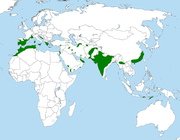 |
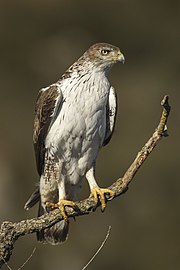 |
|
| Cassin's hawk-eagle | Aquila africana (Cassin, 1865)[5] |
LC IUCN[9] | 670 - 6,700 |  |
||
| African hawk-eagle | Aquila spilogaster (Bonaparte, 1850) |
LC IUCN[10] |  |
 |
||
| Golden eagle | Aquila chrysaetos (Linnaeus, 1758) |
LC IUCN[11] | 100,000 - 200,000 |  |
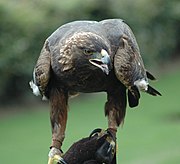 |
|
| Eastern imperial eagle | Aquila heliaca Savigny, 1809 |
VU IUCN[12] | 2,500 - 9,999 |  |
 |
|
| Spanish imperial eagle | Aquila adalberti C. L. Brehm, 1861 |
VU IUCN[13] | 970 |  |
 |
|
| Steppe eagle | Aquila nipalensis (Hodgson, 1833) |
EN IUCN[14] | 50,000 - 75,000 |  |
 |
|
| Tawny eagle | Aquila rapax (Temminck, 1828) |
VU IUCN[15] | 100,000 - 499,999 | 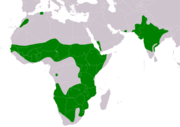 |
 |
|
| Verreaux's eagle | Aquila verreauxii Lesson, 1830 |
LC IUCN[16] |  |
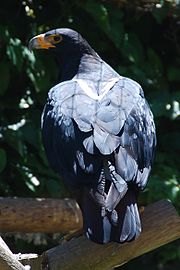 |
||
| Gurney's eagle | Aquila gurneyi Gray, 1860 |
NT IUCN[17] |  |
|||
| Wedge-tailed eagle | Aquila audax (Latham, 1801) |
LC IUCN[18] | 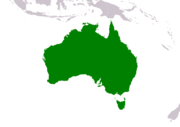 |
 |
||
Fossil record
Numerous fossil taxa of eagles have been described.[19][20] Many have been moved to other genera, but several appear to be correctly assigned to this genus:
Aquila bullockensis (Middle Miocene)
?Aquila delphinensis (Middle/Late Miocene of Grive-Saint-Alban, France)
?Aquila pennatoides (Middle/Late Miocene of Grive-Saint-Alban, France)
Aquila sp. (Late Miocene – Late Pliocene of S Europe)[20]
Aquila sp. (Early Pliocene of Florida)
Aquila bivia (Late Pliocene of S USA)
Aquila kurochkini (Late Pliocene of Varshets, Bulgaria)[21]
Aquila sp. (Middle Pleistocene of Castiglione, Corsica)[22]
?Aquila fossilis (Middle/Late Pleistocene of Monte Reale, Sardinia)
Aquila nipaloides (Pleistocene of Sardinia and Corsica)[23]
?Aquila sp. (Late Quaternary, Madagascar)[24]
Whether "Hieraaetus" edwardsi (Middle -? Late Miocene of SW Europe) belongs into Aquila or the hawk-eagles (if the latter are indeed distinct) is unclear. Its initial name, "Aquila" minuta Milne-Edwards, 1871, is preoccupied by a junior synonym of the booted eagle, A. minuta Brehm, 1831.
Not placed in Aquila anymore are:
"Aquila" gervaisii – now in Palaeohierax
"Aquila" borrasi, "A." sodalis – now in Buteogallus, B. borrasi was long placed in Titanohierax.
"Aquila" pliogryps – now in Spizaetus
"Aquila" corroyi, "A." depredator, "A." hypogaea, and "A." prisca – now in Aquilavus
"Aquila" ferox, "A." lydekkeri – protostrigid owls, now in Minerva.
"Aquila" danana (Snake Creek Late Miocene/Early Pliocene of Loup Fork, USA), occasionally placed in Geranoaetus or Buteo, was a bird of prey of unclear relationships.
Notes
A binomial authority in parentheses indicates that the species was originally described in a genus other than Aquila.
Estimate for the number of mature individuals in the wild.
References
Jobling, James A (2010). The Helm Dictionary of Scientific Bird Names. London: Christopher Helm. p. 52. ISBN 978-1-4081-2501-4.
Brisson, Mathurin Jacques (1760). Ornithologie, ou, Méthode Contenant la Division des Oiseaux en Ordres, Sections, Genres, Especes & leurs Variétés (in French and Latin). Paris: Jean-Baptiste Bauche. Vol. 1, p. 28, Vol. 1, p. 419.
Mayr, Ernst; Cottrell, G. William, eds. (1979). Check-list of Birds of the World. Vol. 1 (2nd ed.). Cambridge, Massachusetts: Museum of Comparative Zoology. p. 378.
Boyd, John Accipitriformes", Taxonomy in Flux Checklist.
Helbig, AJ; Kocum, A; Seibold, I; Braun, MJ (2005). "A multi-gene phylogeny of aquiline eagles (Aves: Accipitriformes) reveals extensive paraphyly at the genus level" (PDF). Molecular Phylogenetics and Evolution. 35 (1): 147–164. doi:10.1016/j.ympev.2004.10.003. PMID 15737588.
See article Hieraaetus for details.
Gill, Frank; Donsker, David, eds. (2019). "New World vultures, Secretarybird, kites, hawks, eagles". World Bird List Version 9.1. International Ornithologists' Union. Archived from the original on 24 April 2020. Retrieved 2 April 2019.
BirdLife International (2015). "Aquila fasciata". IUCN Red List of Threatened Species. 2015. Retrieved 12 April 2015.
"Aquila africana". IUCN Red List of Threatened Species. Retrieved 31 October 2016.
BirdLife International (2012). "Aquila spilogaster". IUCN Red List of Threatened Species. 2012. Retrieved 2 November 2016.
BirdLife International (2013). "Aquila chrysaetos". IUCN Red List of Threatened Species. 2013. Retrieved 2013-11-26.
BirdLife International (2017). "Aquila heliaca". IUCN Red List of Threatened Species. 2017: e.T22696048A117070289. doi:10.2305/IUCN.UK.2017-3.RLTS.T22696048A117070289.en.
BirdLife International (2013). "Aquila adalberti". IUCN Red List of Threatened Species. 2013. Retrieved 26 November 2013.
BirdLife International (2015). "Aquila nipalensis". IUCN Red List of Threatened Species. 2015. Retrieved 24 January 2016.
BirdLife International (2018). "Aquila rapax". IUCN Red List of Threatened Species. 2018. Retrieved 17 December 2018.
BirdLife International (2016). "Aquila verreauxii". IUCN Red List of Threatened Species. 2016: e.T22696067A95221980. doi:10.2305/IUCN.UK.2016-3.RLTS.T22696067A95221980.en.
BirdLife International (2012). "Aquila gurneyi". IUCN Red List of Threatened Species. 2012. Retrieved 26 November 2013.
BirdLife International (2012). "Aquila audax". IUCN Red List of Threatened Species. 2012. Retrieved 26 November 2013.
Brodkorb, Pierce (1964). "Catalogue of Fossil Birds: Part 2 (Anseriformes through Galliformes)". Bulletin of the Florida State Museum. 8 (3): 195–335.
Mlíkovský, Jirí (2002): Cenozoic Birds of the World, Part 1: Europe Archived 2011-03-07 at WebCite . Ninox Press, Prague, p. 194.
Boev, Z., 2013. Aquila kurochkini sp. n., a New Late Pliocene Eagle (Aves, Accipitriformes) from Varshets (NW Bulgaria). - Paleontological Journal, 2013, Vol. 47, No. 11, pp. 1344–1354. Pleiades Publishing, Ltd., 2013.
Salotti, Michelle; Bellot-Gourlet, Ludovic; Courtois, Jean-Yves; et al. (2000). "La fin du Pléistocène supérieur et le début de l'Holocène en Corse: apports paléontologique et archéologique du site de Castiglione (Oletta, Haute-Corse)" [The end of the Late Pleistocene and the Early Holocene in Corsica: New paleontological and archaeological data from Castiglione deposit (Oletta, Haute-Corse)]. Quaternaire (English abstract) (in French). 11 (3): 219–230. doi:10.3406/quate.2000.1671.
Louchart, Dr Antoine; Bedetti, Claudia; Pavia, Dr Marco (2005-05-10). "A new species of eagle (Aves: Accipitridae) close to the Steppe Eagle,from the Pleistocene of Corsica and Sardinia,France and Italy". Palaeontographica Abteilung A (in German). 272 (5–6): 121–148. doi:10.1127/pala/272/2005/121. hdl:2318/80202. S2CID 231030093.
Madagascar and other Islands. Human Settlers Invade Paradise Archived 2007-10-07 at the Wayback Machine. Endangered Species Handbook. Retrieved on 2013-04-17.
Retrieved from "http://en.wikipedia.org/"
All text is available under the terms of the GNU Free Documentation License

